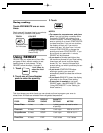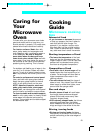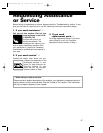
24
• Do not let food or a container touch the
top or sides of the oven. This will prevent
possible arcing.
Using aluminum foil
Metal containers should not be used in a
microwave oven. There are, however, some
exceptions. If you have purchased food
which is prepackaged in an aluminum foil
container, then refer to the instructions on
the package. When using aluminum foil
containers, cooking times may be longer
because microwaves will only penetrate
the top of the food.
If you use aluminum containers without
package instructions, follow these guidelines:
• Place container in a glass bowl and add
some water so that it covers the bottom
of the container, not more than
1
⁄4 inch
(6 mm) high. This ensures even heating
of the container bottom.
• Always remove the lid to avoid damage
to the oven.
• Use only undamaged containers.
• Do not use containers taller than
3
⁄4 inch
(19 mm).
• Container must be half filled.
• To avoid arcing, there must be a minimum
1
⁄
4
inch (6 mm) between the aluminum
container and the walls of the oven and also
between two aluminum containers.
• Always place container on turntable.
• Reheating food in aluminum foil
containers usually takes up to double the
time compared to reheating in plastic, glass,
china, or paper containers. The time when
food is ready will vary depending upon the
type of container you use.
• Let food stand for 2 to 3 minutes after
heating so that heat is spread evenly
throughout container.
Cooking you should not do in
your microwave oven
• Do not do canning of foods in the oven.
Closed glass jars may explode, resulting
in damage to the oven or possible
per-sonal injury.
• Do not use the microwave oven to sterilize
objects (baby bottles, etc.). It is difficult to
maintain the high temperature required for
safe sterilization.
COOKING GUIDE
Covering food
Cover food to:
• Reduce splattering
• Shorten cooking times
• Retain food moisture
All coverings that allow microwaves to
pass through are suitable.
Releasing pressure in foods
• Several foods (for example: baked pota-
toes, sausages, egg yolks, and some fruits)
are tightly covered by a skin or membrane.
This can cause the food to burst from
steam building up in them during cooking.
To relieve the pressure and to prevent
bursting, pierce these foods before cook-
ing with a fork, cocktail pick, or toothpick.
Using standing time
• Always allow food to stand for a while af-
ter cooking. Standing time after defrosting,
cooking, or reheating always improves the
results since the temperature will then be
evenly distributed throughout the food.
• The length of the standing time depends
on the volume and density of the food.
Sometimes it can be as short as the time
it takes you to remove the food from the
oven and take it to the serving table.
However, with larger, denser food,
the standing time may be as long as
10 minutes.
Arranging food
For best results, distribute food evenly on
the plate. You can do this in several ways:
• If you are cooking several items of the
same food, such as baked potatoes, place
them in a ring pattern for uniform cooking.
• When cooking foods of uneven shapes
or thickness, such as chicken breasts,
place the smaller or thinner area of the
food towards the center of the dish where it
will be heated last.
• Layer thin slices of meat on top of
each other.
• When you cook or reheat whole fish,
score the skin – this prevents cracking.
Shield the tail and head of whole fish with
small pieces of foil to prevent overcooking
but ensure the foil does not touch the sides
of the oven.
4393787v06(c100).qx 5/6/98 1:51 PM Page 24


















